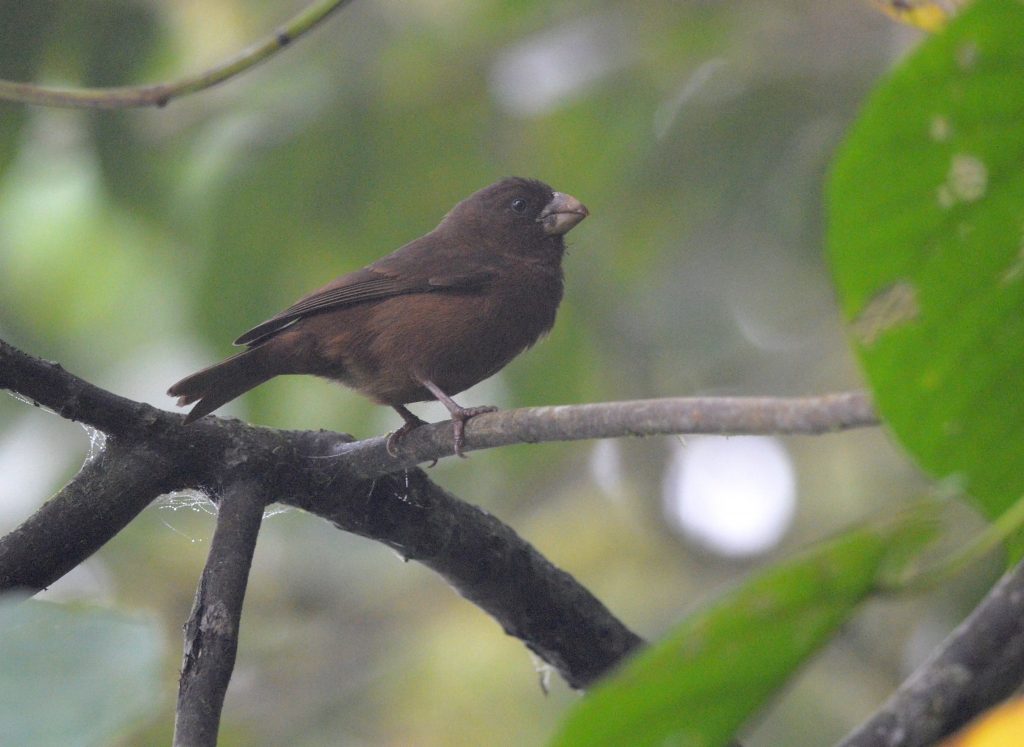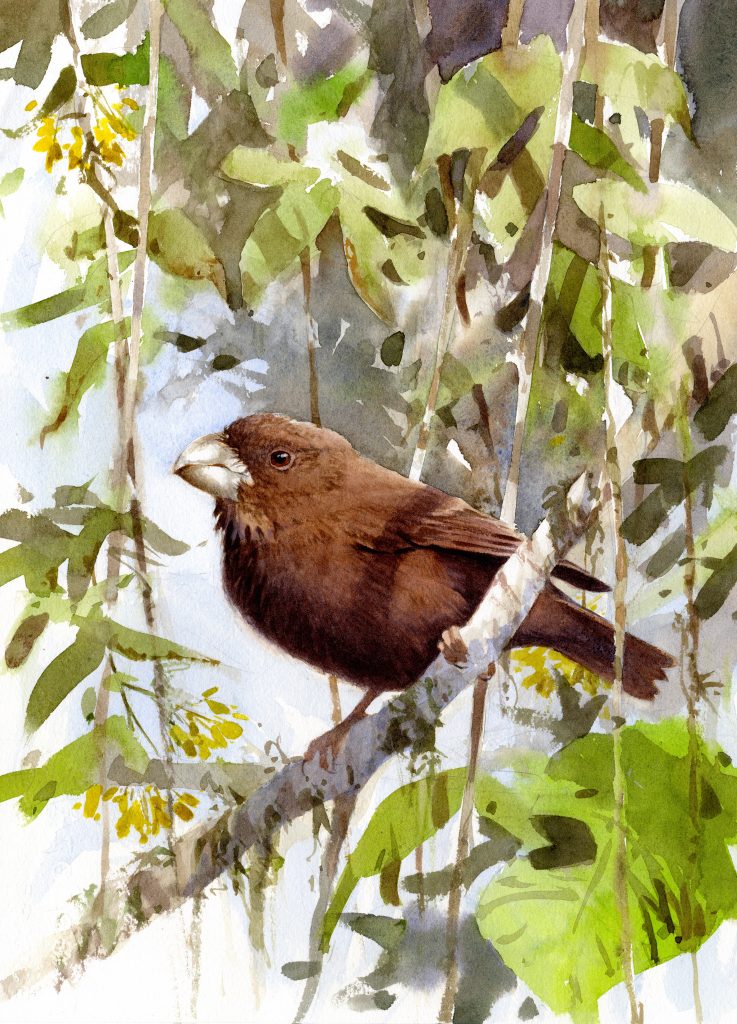We have finally published the first piece of the puzzle about the critically endangered São Tomé grosbeak Neospiza concolor in the ornithological journal Ibis. So what is special about the São Tomé grosbeak? Pretty much everything:
- It is among the rarest species on Earth
- It was not seen for over 100 years
- Taxonomists have fought about what kind of bird it really is
In 1888, the Portuguese naturalist Francisco Newton collected a specimen of an unknown bird species on São Tomé. Two years later, he found another two specimens, and with its large size and massive bill it was originally described as a weaver (family Ploceidae). However, not everyone agreed, and there was an argument about whether it was really a weaver or a finch (family Fringillidae). Eventually, most authorities agreed that it was probably a finch, but its affinities were unclear and it was rewarded its own genus, Neospiza – the new finch.

A rare sighting! This female São Tomé grosbeak (Neospiza concolor) was photographed during our field work on São Tomé, in July 2011. Photo (c): August Thomasson (augustthomasson.weebly.com).
The type specimen is held at the Natural History Museum ornithology collections in Tring, whereas the two others were destroyed in a fire in 1978 at the National Museum of Natural History in Lisbon. After Newton’s initial collections, the São Tomé grosbeak was not sighted again for over 100 years, until it was found by Dave Sergeant three other birders in 1991! Even after its rediscovery, sightings remain very scarce. Until recently, the official population size estimate has been less than 50 individuals, but recent censusing efforts by Ricardo de Lima and colleagues suggest that it might not be just that bad.
Nevertheless, finding São Tomé grosbeaks is a true challenge, and catching them even harder. Martim Melo spent many field seasons in rainforests of the Gulf of Guinea Islands, and could consider himself very lucky to finally catch a couple of individuals. Personally, I am lucky just to have seen one!
Together with Bengt Hansson and Peter Jones, we have used DNA sequencing to establish once and for all what the São Tomé grosbeak really is. We have sequenced a wealth of mitochondrial and nuclear DNA markers, and typed several microsatellite loci. The results are clear: the São Tomé grosbeak is indeed a finch (family Fringillidae). Further, it is nested within the seedeater genus Crithagra, and should thus no longer be called Neospiza (pity on such a nice name!). Finally, it is the sister species of the Príncipe seedeater Crithagra rufobrunnea, another endemic species that inhabits both Príncipe and São Tomé. On the latter island, the Príncipe seedeater is ubiquitous, and occurs side by side with the São Tomé grosbeak. This opens up for very interesting questions about which scenario led to the colonization of two sister species to the same island. Stay tuned, and I promise to deliver part two of the story in due time!
The São Tomé grosbeak breaks the previous world record in body size among seedeaters and canaries (in a wider sense, including the genera Crithagra and Serinus) by far! With its 50 g, it is double the weight of the Príncipe seedeater, which was already the world’s third largest canary. With this, the grosbeak joins the club of other endemic giant species on São Tomé, such as the giant sunbird Dreptes thomensis and the giant weaver Ploceus grandis. They all represent cases of the fascinating island gigantism phenomenon.
So, the beautiful genus name Neospiza is now out of the game, and our enigmatic bird should henceforth be called Crithagra concolor. While São Tomé grosbeak is a well-established vernacular name, it isn’t very accurate, since it indicates something entirely different than a seedeater. I would therefore like to suggest that it may be called the São Tomé giant seedeater. How about that?

This beautiful water color by Peter Nilsson (www.peter-nilsson.com) adorns my living room wall. May I introduce the São Tomé giant seedeater (Crithagra concolor)?

Great news and good article.
Many thanks, Bob! There is more to the story, but that will come a bit later. Btw, I followed the link to your webpage and noticed that there was an error. Thus, clicking your name takes you nowhere, but the correct url is https://islandbiodiversityrace.wordpress.com, for anyone else interested.
Cheers,
Martin
PS. Sorry for WordPress putting my picture next to your name – it’s an annoying bug!
Pingback: The world's largest canary hits the press - Martin StervanderMartin Stervander
Great article! Thank you so much for sharing.
Thanks a lot, Derek! I am happy that you enjoy it. We are working on a follow-up, that I hope will be published soon. (Also, sorry for the annoying bug where WordPress keeps putting my picture on other people’s comments!)
Martin